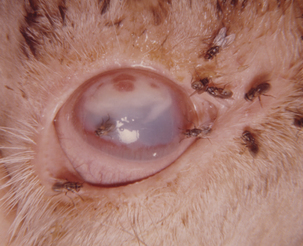Chapter 21 The Genera Moraxella and Neisseria
Members of the genera Moraxella and Neisseria are found on the skin, mucous membranes, and conjunctivae of mammals. The majority of these organisms are harmless commensals, but some are significant pathogens. Species-level classification in the genera Moraxella and Neisseria is evolving and to a great extent incomprehensible.
THE GENUS MORAXELLA
The genus Moraxella belongs to the family Moraxellaceae within the class γ-Proteobacteria. Organisms previously classified as Branhamella species are now in the genus Moraxella. Moraxellae are nonmotile, fastidious, and aerobic; some strains may grow, although poorly, under anaerobic conditions. Optimal growth temperatures are from 33° to 35° C. Most are short, plump, gram-negative coccobacilli, with a tendency toward pleomorphism: some species are more coccoid, whereas others are more bacillary. Species from animals include Moraxella boevrei, Moraxella bovis, Moraxella canis, Moraxella caprae, Moraxella caviae, Moraxella cuniculi, and Moraxella ovis, but disease as a result of species other than M. bovis or M. ovis is rare (Table 21-1). Moraxella (Branhamella) catarrhalis is the most important human pathogen in the genus, causing lower respiratory infection in adults with chronic lung disease, and otitis media, sinusitis, and conjunctivitis in children.
TABLE 21-1 Species of Moraxella and Neisseria with Veterinary Significance
| Species | Habitat | Significance |
|---|---|---|
| M. boevrei | Upper respiratory tract: healthy goats | Commensal |
| M. bovis | Eye, nasal cavity: cattle | Pinkeye |
| M. canis | Upper respiratory tract: healthy dogs, cats | Dog bite infections |
| M. caprae | Nasal cavity, eyes: healthy goats | Commensal |
| M. caviae | Upper respiratory tract: guinea pigs | Commensal |
| M. cuniculi | Oral cavity: healthy rabbits | Commensal |
| Upper respiratory tract: marine mammals | ||
| M. ovis | Eyes: small ruminants | Pinkeye |
| N. animalis | Oropharynx: guinea pig | Commensal |
| N. canis | Oropharynx: dogs, cats | Dog bite infections |
| N. dentiae | Dental plaque: cattle | Commensal |
| N. denitrificans | Upper respiratory tract: guinea pig | Commensal |
| N. iguanae | Oral cavity: iguanid lizards | Rare cutaneous abscesses, septicemia |
| N. macacae | Oropharynx: rhesus monkeys | Commensal |
| N. weaveri | Oropharynx: dogs | Dog bite infections |
MORAXELLA BOVIS
IBK occurs worldwide, and asymptomatic carrier animals introduce the infection into herds. Bacteria may be transmitted animal to animal by direct contact with ocular or nasal exudates or contaminated fomites, and by cows licking their newborn calves. However, intra- and even interherd transmission is mediated mainly by flies (Figures 21-1 and 21-2). The face fly (Musca autumnalis) is the most important species involved in transmission. Most outbreaks occur in grazing cattle in the summer and early autumn, with infection rates decreasing significantly after the first frost.

FIGURE 21-1 Face flies clustered around a bovine eye affected by infectious bovine keratoconjunctivitis.
(Courtesy US Department of Agriculture, Ames, Iowa, National Animal Disease Center.)
Stay updated, free articles. Join our Telegram channel

Full access? Get Clinical Tree


